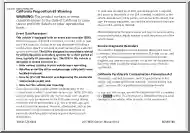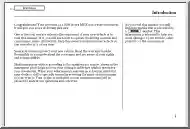No comments yet. You can be the first!
Content extract
Source: http://www.doksinet FEDERATION EUROPEENNE DES MEDECINS SALARIES EUROPEAN FEDERATION OF SALARIED DOCTORS Registered Office/Siège Social : 39, rue Victor Massé F-75009 Paris/France http://www.femsnet Presidency: Dr. Claude Wetzel Hôpitaux Universitaires F-67098 Strasbourg/France Tel +33 3 88 12 70 75 ou 76 GSM +33 6 60 55 56 16 Fax +33 3 88 12 70 74 claude.wetzel@chru-strasbourgfr Date : 13 – 09 - 2011 Title: European Hospital Doctors’ Salaries Authors: Enrico Reginato, Rosario Grosso Document: Permanent Secretariat: Mrs Brigitte Jencik Rue Guimard 15 B-1040 Brussels/Belgium Tel. +32 27 36 60 66 Fax +32 27 32 99 72 e-mail: info@fems.net F11-071 EN Introduction Collecting the data was not very easy; the first way seemed to be simple: asking the EU commission to deliver the national work contracts of EU health workers. We soon discovered that the EU Commission ignores them. I just had the advice to consult the national Medical Associations. Therefore the data we
collected come from different sources ; the colleagues of FEMS sent me the data concerning their Country; for the Countries not represented in FEMS the data come from different sources : direct contacts with delegates of other EMOs we met in their assemblies, Web pages of European Medical Associations. Cyprus and Latvian delegates to CPME, personally contacted, did not sent any reply, therefore the data of these Countries are not present on the diagrams. In some Countries, like Luxemburg, no contract exists and the salary of doctors is decided on a private basis, in other Countries (Bulgaria) only the minimum salary is available, as the higher levels of pay are decided, again, on private basis; other sources (Estonia and Lithuania) just sent the average salary, therefore their position in the following diagrams is different. In Belgium, University doctors have a contract relationship, hospital doctors have a private relationship, therefore the Belgian data must be considered within
these terms. The reported values are intended before taxes and social security withholdings (but this second voice, in some cases, may be absent, as there are different rules on the matter in the different Member Countries). The maximum values are obtained, in some Countries (France, Slovenia.) according to seniority, in other Countries the salary is connected to the position (e.g Consultants in UK) and in Italy, where the maximum levels concern a limited number of doctors (coordinators of departments). The preliminary data were shown in Barcelona GA and we kept into consideration the remarks from FEMS delegates. The data underwent correction based on the purchasing power parity (PPP), obtained by Eurostat documents. The data were also compared with the average salary of the individual Countries (still Eurostat data), before and after PPP correction. -1- Source: http://www.doksinet Working group on European Salaries 2011 We considered important to insert the per head total
expenditure on social protection distributed by the single Member Countries, to check if, in case of low salaries, a kind of compensation could come from those funds. Gross salaries Tab1 Maximum and minimum salaries Source: http://www.doksinet Source: http://www.doksinet Working group on European Salaries 2011 Purchasing Power Parity Purchasing power parities (PPPs) are indicators of price level differences across countries. They indicate how many currency units a particular quantity of goods and services costs in different countries. It is useful because often the amount of goods a currency can purchase within two nations varies drastically, based on availability of goods, demand for the goods, and a number of other, difficult to determine factors. PPPs for European countries are annual benchmark results calculated by Eurostat 1. Per capita volume indices should not be used to rank countries as PPPs are statistical constructs rather than precise measures. Minor differences
between countries should be interpreted with caution 1 http://epp.eurostateceuropaeu/portal/page/portal/purchasing power parities/introduction Source: http://www.doksinet Source: http://www.doksinet Working group on European Salaries 2011 Average European Salaries We benchmarked the doctors’ salaries with the average European salaries, as obtained by OECD data,2 The following values were obtained dividing the yearly salary by 12, to obtain n average monthly salary. The data were corrected, as we did for doctors’ salaries, according to the PPP : 2 http://stats.oecdorg/indexaspx?queryid=19802 Source: http://www.doksinet After correction of the data according to the PPP, the following table was obtained : In some cases (Finland, France, Germany, Italy, Poland, Slovenia) the minimum doctors’ salaries is equivalent to the average national salary; in Belgium, Denmark, Italy, the Netherland and Slovakia the minimum doctors’ salary is higher than the average salary ; in
Austria, Ireland, Portugal, Romania, Spain, Sweden and UK, the average salary is placed between the maximum and minimum doctors’ salary ; in some case the maximum doctors’ salary is equal (Greece and Malta) or even lower (Czech Republic and Hungary) than the average national salary. These data, of course, must be considered in their relativity, as the absolute values show great difference among the individual Member States. From other Countries we could only receive the average value of salaries and in one case (Bulgaria) only the minimum value Besides, these data concern the salary of doctors, but little we can say about different incomes from private practice
collected come from different sources ; the colleagues of FEMS sent me the data concerning their Country; for the Countries not represented in FEMS the data come from different sources : direct contacts with delegates of other EMOs we met in their assemblies, Web pages of European Medical Associations. Cyprus and Latvian delegates to CPME, personally contacted, did not sent any reply, therefore the data of these Countries are not present on the diagrams. In some Countries, like Luxemburg, no contract exists and the salary of doctors is decided on a private basis, in other Countries (Bulgaria) only the minimum salary is available, as the higher levels of pay are decided, again, on private basis; other sources (Estonia and Lithuania) just sent the average salary, therefore their position in the following diagrams is different. In Belgium, University doctors have a contract relationship, hospital doctors have a private relationship, therefore the Belgian data must be considered within
these terms. The reported values are intended before taxes and social security withholdings (but this second voice, in some cases, may be absent, as there are different rules on the matter in the different Member Countries). The maximum values are obtained, in some Countries (France, Slovenia.) according to seniority, in other Countries the salary is connected to the position (e.g Consultants in UK) and in Italy, where the maximum levels concern a limited number of doctors (coordinators of departments). The preliminary data were shown in Barcelona GA and we kept into consideration the remarks from FEMS delegates. The data underwent correction based on the purchasing power parity (PPP), obtained by Eurostat documents. The data were also compared with the average salary of the individual Countries (still Eurostat data), before and after PPP correction. -1- Source: http://www.doksinet Working group on European Salaries 2011 We considered important to insert the per head total
expenditure on social protection distributed by the single Member Countries, to check if, in case of low salaries, a kind of compensation could come from those funds. Gross salaries Tab1 Maximum and minimum salaries Source: http://www.doksinet Source: http://www.doksinet Working group on European Salaries 2011 Purchasing Power Parity Purchasing power parities (PPPs) are indicators of price level differences across countries. They indicate how many currency units a particular quantity of goods and services costs in different countries. It is useful because often the amount of goods a currency can purchase within two nations varies drastically, based on availability of goods, demand for the goods, and a number of other, difficult to determine factors. PPPs for European countries are annual benchmark results calculated by Eurostat 1. Per capita volume indices should not be used to rank countries as PPPs are statistical constructs rather than precise measures. Minor differences
between countries should be interpreted with caution 1 http://epp.eurostateceuropaeu/portal/page/portal/purchasing power parities/introduction Source: http://www.doksinet Source: http://www.doksinet Working group on European Salaries 2011 Average European Salaries We benchmarked the doctors’ salaries with the average European salaries, as obtained by OECD data,2 The following values were obtained dividing the yearly salary by 12, to obtain n average monthly salary. The data were corrected, as we did for doctors’ salaries, according to the PPP : 2 http://stats.oecdorg/indexaspx?queryid=19802 Source: http://www.doksinet After correction of the data according to the PPP, the following table was obtained : In some cases (Finland, France, Germany, Italy, Poland, Slovenia) the minimum doctors’ salaries is equivalent to the average national salary; in Belgium, Denmark, Italy, the Netherland and Slovakia the minimum doctors’ salary is higher than the average salary ; in
Austria, Ireland, Portugal, Romania, Spain, Sweden and UK, the average salary is placed between the maximum and minimum doctors’ salary ; in some case the maximum doctors’ salary is equal (Greece and Malta) or even lower (Czech Republic and Hungary) than the average national salary. These data, of course, must be considered in their relativity, as the absolute values show great difference among the individual Member States. From other Countries we could only receive the average value of salaries and in one case (Bulgaria) only the minimum value Besides, these data concern the salary of doctors, but little we can say about different incomes from private practice




